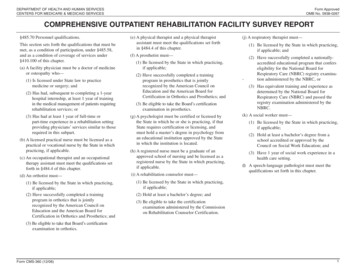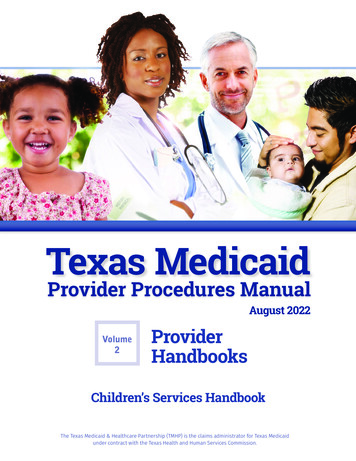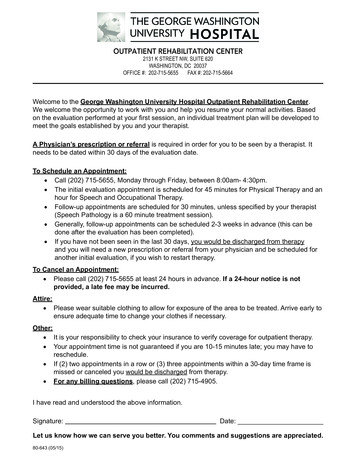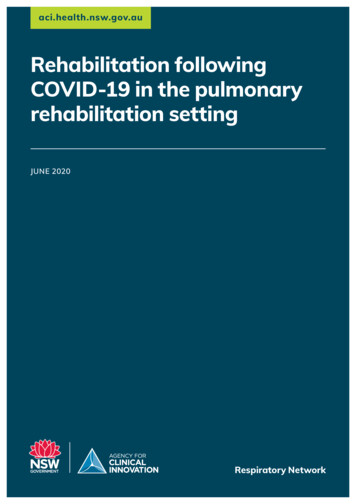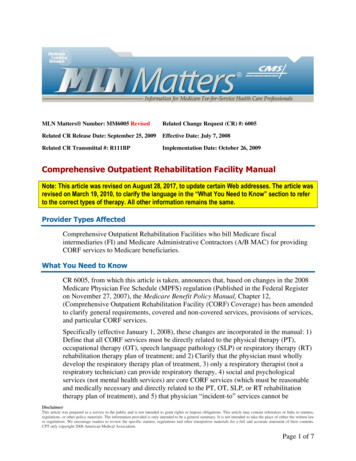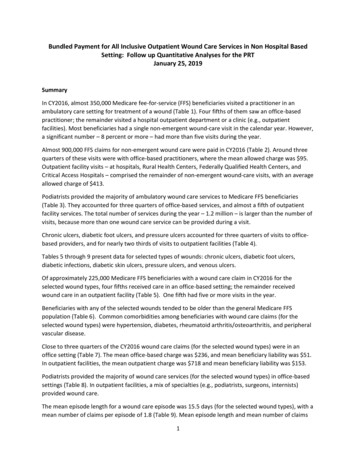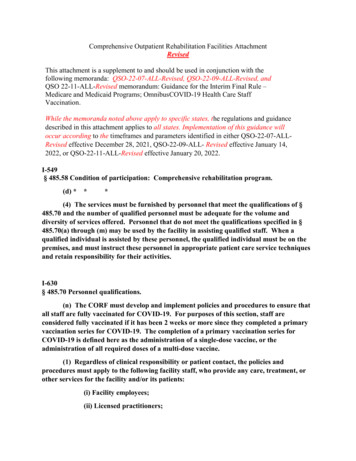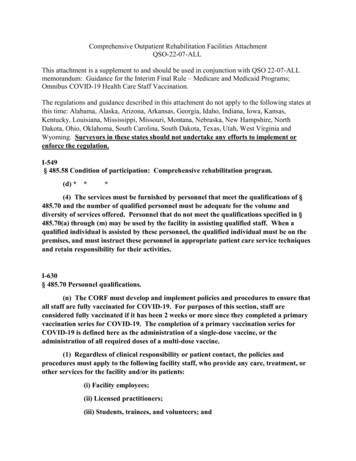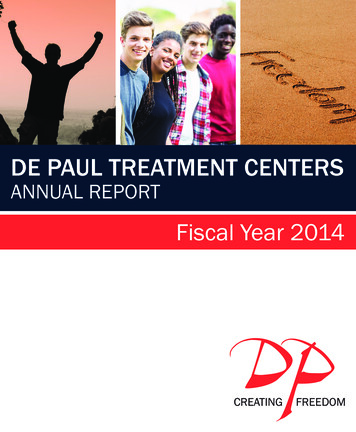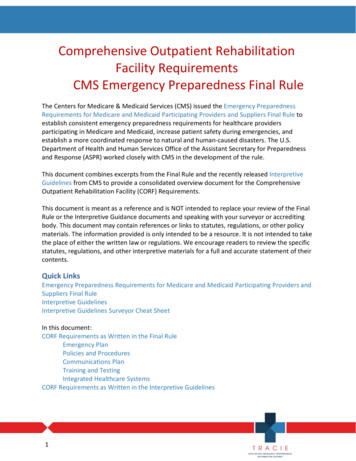
Transcription
Comprehensive Outpatient RehabilitationFacility RequirementsCMS Emergency Preparedness Final RuleThe Centers for Medicare & Medicaid Services (CMS) issued the Emergency PreparednessRequirements for Medicare and Medicaid Participating Providers and Suppliers Final Rule toestablish consistent emergency preparedness requirements for healthcare providersparticipating in Medicare and Medicaid, increase patient safety during emergencies, andestablish a more coordinated response to natural and human-caused disasters. The U.S.Department of Health and Human Services Office of the Assistant Secretary for Preparednessand Response (ASPR) worked closely with CMS in the development of the rule.This document combines excerpts from the Final Rule and the recently released InterpretiveGuidelines from CMS to provide a consolidated overview document for the ComprehensiveOutpatient Rehabilitation Facility (CORF) Requirements.This document is meant as a reference and is NOT intended to replace your review of the FinalRule or the Interpretive Guidance documents and speaking with your surveyor or accreditingbody. This document may contain references or links to statutes, regulations, or other policymaterials. The information provided is only intended to be a resource. It is not intended to takethe place of either the written law or regulations. We encourage readers to review the specificstatutes, regulations, and other interpretive materials for a full and accurate statement of theircontents.Quick LinksEmergency Preparedness Requirements for Medicare and Medicaid Participating Providers andSuppliers Final RuleInterpretive GuidelinesInterpretive Guidelines Surveyor Cheat SheetIn this document:CORF Requirements as Written in the Final RuleEmergency PlanPolicies and ProceduresCommunications PlanTraining and TestingIntegrated Healthcare SystemsCORF Requirements as Written in the Interpretive Guidelines1
CORF Requirements as Written in the Final RuleThe following excerpt is taken from page 64030 of the Final Rule, accessible directly by this p-amd-31.Add § 485.68 to read as follows:§ 485.68 Condition of participation:Emergency preparedness.The Comprehensive Outpatient Rehabilitation Facility (CORF) must comply with all applicableFederal, State, and local emergency preparedness requirements. The CORF must establish andmaintain an emergency preparedness program that meets the requirements of this section. Theemergency preparedness program must include, but not be limited to, the following elements:(a) Emergency plan. The CORF must develop and maintain an emergency preparedness planthat must be reviewed and updated at least annually. The plan must do all of the following:1) Be based on and include a documented, facility-based and community-based riskassessment, utilizing an all-hazards approach.2) Include strategies for addressing emergency events identified by the riskassessment.3) Address patient population, including, but not limited to, the type of services theCORF has the ability to provide in an emergency; and continuity of operations,including delegations of authority and succession plans.4) Include a process for cooperation and collaboration with local, tribal, regional, State,and Federal emergency preparedness officials' efforts to maintain an integratedresponse during a disaster or emergency situation, including documentation of theCORF's efforts to contact such officials and, when applicable, of its participation incollaborative and cooperative planning efforts;5) Be developed and maintained with assistance from fire, safety, and otherappropriate experts.(b) Policies and procedures. The CORF must develop and implement emergencypreparedness policies and procedures, based on the emergency plan set forth in paragraph (a)of this section, risk assessment at paragraph (a)(1) of this section, and the communication planat paragraph (c) of this section. The policies and procedures must be reviewed and updated atleast annually. At a minimum, the policies and procedures must address the following:1) Safe evacuation from the CORF, which includes staff responsibilities, and needs ofthe patients.2) A means to shelter in place for patients, staff, and volunteers who remain in thefacility.3) A system of medical documentation that preserves patient information, protectsconfidentiality of patient information, and secures and maintains the availability ofrecords.2
4) The use of volunteers in an emergency and other emergency staffing strategies,including the process and role for integration of State or Federally designated healthcare professionals to address surge needs during an emergency.(c) Communication plan. The CORF must develop and maintain an emergencypreparedness communication plan that complies with Federal, State, and local laws and mustbe reviewed and updated at least annually. The communication plan must include all of thefollowing:1) Names and contact information for the following:i. Staff.ii. Entities providing services under arrangement.iii. Patients' physicians.iv. Other CORFs.v. Volunteers.2) Contact information for the following:i. Federal, State, tribal, regional and local emergency preparedness staff.ii. Other sources of assistance.3) Primary and alternate means for communicating with the CORF's staff, Federal,State, tribal, regional, and local emergency management agencies.4) A method for sharing information and medical documentation for patients underthe CORF's care, as necessary, with other health care providers to maintain thecontinuity of care.5) A means of providing information about the CORF's needs, and its ability to provideassistance, to the authority having jurisdiction or the Incident Command Center, ordesignee.(d) Training and testing. The CORF must develop and maintain an emergency preparednesstraining and testing program that is based on the emergency plan set forth in paragraph (a) ofthis section, risk assessment at paragraph (a)(1) of this section, policies and procedures atparagraph (b) of this section, and the communication plan at paragraph (c) of this section. Thetraining and testing program must be reviewed and updated at least annually.1) Training program. The CORF must do all of the following:i. Provide initial training in emergency preparedness policies and procedures toall new and existing staff, individuals providing services under arrangement,and volunteers, consistent with their expected roles.ii. Provide emergency preparedness training at least annually.iii. Maintain documentation of the training.iv. Demonstrate staff knowledge of emergency procedures. All new personnelmust be oriented and assigned specific responsibilities regarding the CORF'semergency plan within 2 weeks of their first workday. The training programmust include instruction in the location and use of alarm systems and signalsand firefighting equipment.3
2) Testing. The CORF must conduct exercises to test the emergency plan at leastannually. The CORF must do the following:i. Participate in a full-scale exercise that is community-based or when acommunity-based exercise is not accessible, an individual, facility-based. Ifthe CORF experiences an actual natural or man-made emergency thatrequires activation of the emergency plan, the CORF is exempt from engagingin a community-based or individual, facility-based full-scale exercise for 1year following the onset of the actual event.ii. Conduct an additional exercise that may include, but is not limited to thefollowing:a) A second full-scale exercise that is community-based or individual,facility-based.b) A tabletop exercise that includes a group discussion led by a facilitator,using a narrated, clinically-relevant emergency scenario, and a set ofproblem statements, directed messages, or prepared questions designedto challenge an emergency plan.iii. Analyze the CORF's response to and maintain documentation of all drills,tabletop exercises, and emergency events, and revise the CORF's emergencyplan, as needed.(e) Integrated healthcare systems. If a CORF is part of a healthcare system consisting ofmultiple separately certified healthcare facilities that elects to have a unified and integratedemergency preparedness program, the CORF may choose to participate in the healthcaresystem's coordinated emergency preparedness program. If elected, the unified and integratedemergency preparedness program must do all of the following:1) Demonstrate that each separately certified facility within the system activelyparticipated in the development of the unified and integrated emergencypreparedness program.2) Be developed and maintained in a manner that takes into account each separatelycertified facility's unique circumstances, patient populations, and services offered.3) Demonstrate that each separately certified facility is capable of actively using theunified and integrated emergency preparedness program and is in compliance withthe program.4) Include a unified and integrated emergency plan that meets the requirements ofparagraphs (a)(2), (3), and (4) of this section. The unified and integrated emergencyplan must also be based on and include the following:i. A documented community-based risk assessment, utilizing an all-hazardsapproach.ii. A documented individual facility-based risk assessment for each separatelycertified facility within the health system, utilizing an all-hazards approach.5) Include integrated policies and procedures that meet the requirements set forth inparagraph (b) of this section, a coordinated communication plan and training and4
testing programs that meet the requirements of paragraphs (c) and (d) of thissection, respectively.5
Interpretive Guidelines References for CORFsFull text available at: Appendix Z – Emergency Preparedness for All Providers and Certified Supplier Types: Interpretive GuidelinesFull Surveyor Cheat Sheet Spreadsheet available at: veyor-Tool-EPTags.xlsx6
CORF References as Outlined in the Interpretive Guidance and the Surveyor Cheat SheetTag # TitleTag Text (Regulatory Text)0001Establishment of theEmergency Program(EP)The [facility, except for Transplant Center] must comply with allapplicable Federal, State and local emergency preparednessrequirements. The [facility] must establish and maintain acomprehensive emergency preparedness program that meets therequirements of this section.* The emergency preparedness programmust include, but not be limited to, the following elements:*[For hospitals at §482.15:] The hospital must comply with all applicableFederal, State, and local emergency preparedness requirements. Thehospital must develop and maintain a comprehensive emergencypreparedness program that meets the requirements of this section,utilizing an all-hazards approach.*[For CAHs at §485.625:] The CAH must comply with all applicableFederal, State, and local emergency preparedness requirements. TheCAH must develop and maintain a comprehensive emergencypreparedness program, utilizing an all-hazards approach.Interpretive GuidelinesUnder this condition/requirement, facilities are required to develop an emergency preparednessprogram that meets all of the standards specified within the condition/requirement. The emergencypreparedness program must describe a facility's comprehensive approach to meeting the health, safety,and security needs of their staff and patient population during an emergency or disaster situation. Theprogram must also address how the facility would coordinate with other healthcare facilities, as well asthe whole community during an emergency or disaster (natural, man-made, facility). The emergencypreparedness program must be reviewed annually.A comprehensive approach to meeting the health and safety needs of a patient population shouldencompass the elements for emergency preparedness planning based on the “all-hazards” definitionand specific to the location of the facility. For instance, a facility in a large flood zone, or tornado proneregion, should have included these elements in their overall planning in order to meet the health,safety, and security needs of the staff and of the patient population. Additionally, if the patientpopulation has limited mobility, facilities should have an approach to address these challenges duringemergency events. The term “comprehensive” in this requirement is to ensure that facilities do notonly choose one potential emergency that may occur in their area, but rather consider a multitude ofevents and be able to demonstrate that they have considered this during their development of theemergency preparedness plan.Survey Procedures Interview the facility leadership and ask him/her/them to describe the facility’s emergencypreparedness program. Ask to see the facility’s written policy and documentation on the emergency preparednessprogram. For hospitals and CAHs only: Verify the hospital’s or CAH’s program was developed based on anall-hazards approach by asking their leadership to describe how the facility used an all-hazardsapproach when developing its program.7
Tag #0004TitleDevelop and MaintainEP ProgramTag Text (Regulatory Text)[The [facility] must comply with all applicable Federal, State and localemergency preparedness requirements. The [facility] must developestablish and maintain a comprehensive emergency preparednessprogram that meets the requirements of this section.]* [For hospitals at §482.15 and CAHs at §485.625(a):] The [hospital orCAH] must comply with all applicable Federal, State, and localemergency preparedness requirements. The [hospital or CAH] mustdevelop and maintain a comprehensive emergency preparednessprogram that meets the requirements of this section, utilizing an allhazards approach.]The emergency preparedness program must include, but not be limitedto, the following elements:](a) Emergency Plan. The [facility] must develop and maintain anemergency preparedness plan that must be [reviewed], and updated atleast annually.* [For ESRD Facilities at §494.62(a):] Emergency Plan. The ESRD facilitymust develop and maintain an emergency preparedness plan that mustbe [evaluated], and updated at least annually.Interpretive GuidelinesFacilities are required to develop and maintain an emergency preparedness plan. The plan must includeall of the required elements under the standard. The plan must be reviewed and updated at leastannually. The annual review must be documented to include the date of the review and any updatesmade to the emergency plan based on the review. The format of the emergency preparedness plan thata facility uses is at its discretion.An emergency plan is one part of a facility's emergency preparedness program. The plan provides theframework, which includes conducting facility-based and community-based risk assessments that willassist a facility in addressing the needs of their patient populations, along with identifying the continuityof business operations which will provide support during an actual emergency. In addition, theemergency plan supports, guides, and ensures a facility's ability to collaborate with local emergencypreparedness officials. This approach is specific to the location of the facility and considers particularhazards most likely to occur in the surrounding area. These include, but are not limited to: Natural disasters, Man-made disasters, Facility-based disasters that include but are not limited to:o Care-related emergencies;o Equipment and utility failures, including but not limited to power, water, gas, etc.;o Interruptions in communication, including cyber-attacks;o Loss of all or portion of a facility; ando Interruptions to the normal supply of essential resources, such as water, food, fuel(heating, cooking, and generators), and in some cases, medications and medicalsupplies (including medical gases, if applicable).When evaluating potential interruptions to the normal supply of essential services, the facility shouldtake into account the likely durations of such interruptions. Arrangements or contracts to re-establishessential utility services during an emergency should describe the timeframe within which thecontractor is required to initiate services after the start of the emergency, how they will be procuredand delivered in the facility’s local area, and that the contractor will continue to supply the essentialitems throughout and to the end of emergencies of varying duration.8
Tag #TitleTag Text (Regulatory Text)Interpretive Guidelines0006Maintain and AnnualEP Updates[(a) Emergency Plan. The [facility] must develop and maintain anemergency preparedness plan that must be reviewed, and updated atleast annually. The plan must do the following:]Facilities are expected to develop an emergency preparedness plan that is based on the facility-basedand community-based risk assessment using an “all-hazards” approach. Facilities must document bothrisk assessments. An example consideration may include, but is not limited to, natural disastersprevalent in a facility’s geographic region such as wildfires, tornados, flooding, etc. An all-hazardsapproach is an integrated approach to emergency preparedness planning that focuses on capacities andcapabilities that are critical to preparedness for a full spectrum of emergencies or disasters. Thisapproach is specific to the location of the facility considering the types of hazards most likely to occur inthe area. Thus, all-hazards planning does not specifically address every possible threat or risk butensures the facility will have the capacity to address a broad range of related emergencies. Facilities areencouraged to utilize the concepts outlined in the National Preparedness System, published by theUnited States Department of Homeland Security’s Federal Emergency Management Agency (FEMA), aswell as guidance provided by the Agency for Healthcare Research and Quality (AHRQ).(1) Be based on and include a documented, facility-based andcommunity-based risk assessment, utilizing an all-hazards approach.**[For LTC facilities at §483.73(a)(1):] (1) Be based on and include adocumented, facility-based and community-based risk assessment,utilizing an all-hazards approach, including missing residents.*[For ICF/IIDs at §483.475(a)(1):] (1) Be based on and include adocumented, facility-based and community-based risk assessment,utilizing an all-hazards approach, including missing clients.(2) Include strategies for addressing emergency events identified by therisk assessment.* [For Hospices at §418.113(a)(2):] (2) Include strategies for addressingemergency events identified by the risk assessment, including themanagement of the consequences of power failures, natural disasters,and other emergencies that would affect the hospice’s ability to providecare.9Survey Procedures Verify the facility has an emergency preparedness plan by asking to see a copy of the plan. Ask facility leadership to identify the hazards (e.g. natural, man-made, facility, geographic, etc.)that were identified in the facility’s risk assessment and how the risk assessment wasconducted. Review the plan to verify it contains all of the required elements. Verify that the plan is reviewed and updated annually by looking for documentation of the dateof the review and updates that were made to the plan based on the review.“Community” is not defined in order to afford facilities the flexibility in deciding which healthcarefacilities and agencies it considers to be part of its community for emergency planning purposes.However, the term could mean entities within a state or multi-state region. The goal of the provision isto ensure that healthcare providers collaborate with other entities within a given community topromote an integrated response. Conducting integrated planning with state and local entities couldidentify potential gaps in state and local capabilities that can then be addressed in advance of anemergency.Facilities may rely on a community-based risk assessment developed by other entities, such as publichealth agencies, emergency management agencies, and regional health care coalitions or in conjunction
Tag #TitleTag Text (Regulatory Text)Interpretive Guidelineswith conducting its own facility-based assessment. If this approach is used, facilities are expected tohave a copy of the community-based risk assessment and to work with the entity that developed it toensure that the facility’s emergency plan is in alignment.When developing an emergency preparedness plan, facilities are expected to consider, among otherthings, the following: Identification of all business functions essential to the facility’s operations that should becontinued during an emergency; Identification of all risks or emergencies that the facility may reasonably expect to confront; Identification of all contingencies for which the facility should plan; Consideration of the facility’s location; Assessment of the extent to which natural or man-made emergencies may cause the facility tocease or limit operations; and, Determination of what arrangements may be necessary with other health care facilities, orother entities that might be needed to ensure that essential services could be provided duringan emergency.In situations where the facility does not own the structure(s) where care is provided, it is the facility’sresponsibility to discuss emergency preparedness concerns with the landlord to ensure continuation ofcare if the structure of the building and its utilities are impacted.For LTC facilities and ICF/IIDs, written plans and the procedures are required to also include missingresidents and clients, respectively, within their emergency plans.Facilities must develop strategies for addressing emergency events that were identified during thedevelopment of the facility- and community-based risk assessments. Examples of these strategies mayinclude, but are not limited to, developing a staffing strategy if staff shortages were identified during therisk assessment or developing a surge capacity strategy if the facility has identified it would likely berequested to accept additional patients during an emergency. Facilities will also want to considerevacuation plans. For example, a facility in a large metropolitan city may plan to utilize the support ofother large community facilities as alternate care sites for its patients if the facility needs to beevacuated. The facility is also expected to have a backup evacuation plan for instances in which nearbyfacilities are also affected by the emergency and are unable to receive patients10
Tag #TitleTag Text (Regulatory Text)Interpretive GuidelinesHospices must include contingencies for managing the consequences of power failures, naturaldisasters, and other emergencies that would affect the hospice’s ability to provide care.Survey Procedures Ask to see the written documentation of the facility’s risk assessments and associatedstrategies. Interview the facility leadership and ask which hazards (e.g. natural, man-made, facility,geographic) were included in the facility’s risk assessment, why they were included and howthe risk assessment was conducted. Verify the risk-assessment is based on an all-hazards approach specific to the geographiclocation of the facility and encompasses potential hazards.0007EP Program PatientPopulation11[(a) Emergency Plan. The [facility] must develop and maintain anemergency preparedness plan that must be reviewed, and updated atleast annually. The plan must do the following:](3) Addresspatient/client population, including, but not limited to, persons at-risk;the type of services the [facility] has the ability to provide in anemergency; and continuity of operations, including delegations ofauthority and succession plans.** *Note: [“Persons at risk” does notapply to: ASC, hospice, PACE, HHA, CORF, CMCH, RHC, FQHC, or ESRDfacilities.]The emergency plan must specify the population served within the facility, such as inpatients and/oroutpatients, and their unique vulnerabilities in the event of an emergency or disaster. A facility’semergency plan must also address persons at-risk, except for plans of ASCs, hospices, PACEorganizations, HHAs, CORFs, CMHCs, RHCs, FQHCs and ESRD facilities. As defined by the Pandemic andAll-Hazards Preparedness Act (PAHPA) of 2006, members of at-risk populations may have additionalneeds in one or more of the following functional areas: maintaining independence, communication,transportation, supervision, and medical care. In addition to those individuals specifically recognized asat-risk in the PAHPA (children, senior citizens, and pregnant women), “at-risk populations” are alsoindividuals who may need additional response assistance including those who have disabilities, live ininstitutionalized settings, are from diverse cultures and racial and ethnic backgrounds, have limitedEnglish proficiency or are non-English speaking, lack transportation, have chronic medical disorders, orhave pharmacological dependency. At-risk populations would also include, but are not limited to, theelderly, persons in hospitals and nursing homes, people with physical and mental disabilities as well asothers with access and functional needs, and infants and children. Mobility is an important part ineffective and timely evacuations, and therefore facilities are expected to properly plan to identifypatients who would require additional assistance, ensure that means for transport are accessible andavailable and that those involved in transport, as well as the patients and residents are made aware ofthe procedures to evacuate. For outpatient facilities, such as Home Health Agencies (HHAs), theemergency plan is required to ensure that patients with limited mobility are addressed within the plan.The emergency plan must also address the types of services that the facility would be able to provide inan emergency. The emergency plan must identify which staff would assume specific roles in another’sabsence through succession planning and delegations of authority. Succession planning is a process foridentifying and developing internal people with the potential to fill key business leadership positions in
Tag #TitleTag Text (Regulatory Text)Interpretive Guidelinesthe company. Succession planning increases the availability of experienced and capable employees thatare prepared to assume these roles as they become available. During times of emergency, facilitiesmust have employees who are capable of assuming various critical roles in the event that current staffand leadership are not available. At a minimum, there should be a qualified person who "is authorizedin writing to act in the absence of the administrator or person legally responsible for the operations ofthe facility."In addition to the facility- and community-based risk assessment, continuity of operationsplanning generally considers elements such as: essential personnel, essential functions, criticalresources, vital records and IT data protection, alternate facility identification and location, and financialresources. Facilities are encouraged to refer to and utilize resources from various agencies such as FEMAand Assistant Secretary for Preparedness and Response (ASPR) when developing strategies for ensuringcontinuity of operations. Facilities are encouraged to refer to and utilize resources from variousagencies such as FEMA and ASPR when developing strategies for ensuring continuity of operations.Survey Procedures Interview leadership and ask them to describe the following:o The facility’s patient populations that would be at risk during an emergency event;o Strategies the facility (except for an ASC, hospice, PACE organization, HHA, CORF,CMHC, RHC, FQHC and ESRD facility) has put in place to address the needs of at-risk orvulnerable patient populations;o Services the facility would be able to provide during an emergency;o How the facility plans to continue operations during an emergency;o Delegations of authority and succession plans. Verify that all of the above are included in the written emergency plan.12
Tag #0009TitleProcess for EPCollaborationTag Text (Regulatory Text)[(a) Emergency Plan. The [facility] must develop and maintain anemergency preparedness plan that must be reviewed, and updated atleast annually. The plan must do the following:](4) Include a process for cooperation and collaboration with local, tribal,regional, State, and Federal emergency preparedness officials' efforts tomaintain an integrated response during a disaster or emergencysituation, including documentation of the facility's efforts to contactsuch officials and, when applicable, of its participation in collaborativeand cooperative planning efforts. *** [For ESRD facilities only at §494.62(a)(4)]: (4) Include a process forcooperation and collaboration with local, tribal, regional, State, andFederal emergency preparedness officials' efforts to maintain anintegrated response during a disaster or emergency situation, includingdocumentation of the dialysis facility's efforts to contact such officialsand, when applicable, of its participation in collaborative andcooperative planning efforts. The dialysis facility must contact the localemergency preparedness agency at least annually to confirm that theagency is aware of the dialysis facility’s needs in the event of anemergency.13Interpretive GuidelinesWhile the responsibility for ensuring a coordinated disaster preparedness response lies upon the stateand local emergency planning authorities, the facility must document its efforts to contact theseofficials to engage in collaborative planning for an integrated emergency response. The facility mustinclude this integrated response process in its emergency plan. Facilities are encouraged to participatein a healthcare coalition as it may provide assistance in planning and addressing broader communit
The Comprehensive Outpatient Rehabilitation Facility (CORF) must comply with all applicable Federal, State, and local emergency preparedness requirements. The CORF must establish and . facilities should have an approach to address these challenges during emergency events. The term "comprehensive" in this requirement is to ensure that .
